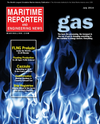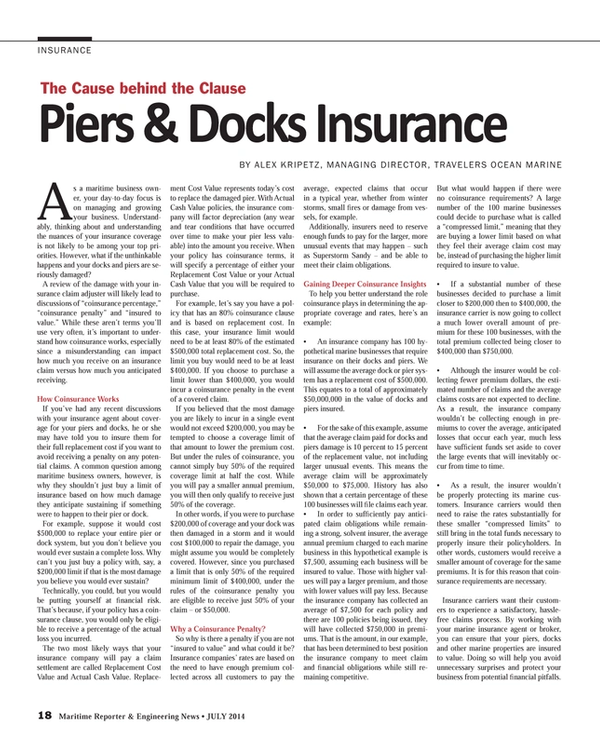
The Cause behind the Clause Piers & Docks Insurance
As a maritime business owner, your day-to-day focus is on managing and growing your business. Understandably, thinking about and understanding the nuances of your insurance coverage is not likely to be among your top priorities. However, what if the unthinkable happens and your docks and piers are seriously damaged?
A review of the damage with your insurance claim adjuster will likely lead to discussions of “coinsurance percentage,” “coinsurance penalty” and “insured to value.” While these aren’t terms you’ll use very often, it’s important to understand how coinsurance works, especially since a misunderstanding can impact how much you receive on an insurance claim versus how much you anticipated receiving.
How Coinsurance Works
If you’ve had any recent discussions with your insurance agent about coverage for your piers and docks, he or she may have told you to insure them for their full replacement cost if you want to avoid receiving a penalty on any potential claims. A common question among maritime business owners, however, is why they shouldn’t just buy a limit of insurance based on how much damage they anticipate sustaining if something were to happen to their pier or dock.
For example, suppose it would cost $500,000 to replace your entire pier or dock system, but you don’t believe you would ever sustain a complete loss. Why can’t you just buy a policy with, say, a $200,000 limit if that is the most damage you believe you would ever sustain?
Technically, you could, but you would be putting yourself at financial risk. That’s because, if your policy has a coinsurance clause, you would only be eligible to receive a percentage of the actual loss you incurred.
The two most likely ways that your insurance company will pay a claim settlement are called Replacement Cost Value and Actual Cash Value. Replacement Cost Value represents today’s cost to replace the damaged pier. With Actual Cash Value policies, the insurance company will factor depreciation (any wear and tear conditions that have occurred over time to make your pier less valuable) into the amount you receive. When your policy has coinsurance terms, it will specify a percentage of either your Replacement Cost Value or your Actual Cash Value that you will be required to purchase.
For example, let’s say you have a policy that has an 80% coinsurance clause and is based on replacement cost. In this case, your insurance limit would need to be at least 80% of the estimated $500,000 total replacement cost. So, the limit you buy would need to be at least $400,000. If you choose to purchase a limit lower than $400,000, you would incur a coinsurance penalty in the event of a covered claim.
If you believed that the most damage you are likely to incur in a single event would not exceed $200,000, you may be tempted to choose a coverage limit of that amount to lower the premium cost. But under the rules of coinsurance, you cannot simply buy 50% of the required coverage limit at half the cost. While you will pay a smaller annual premium, you will then only qualify to receive just 50% of the coverage.
In other words, if you were to purchase $200,000 of coverage and your dock was then damaged in a storm and it would cost $100,000 to repair the damage, you might assume you would be completely covered. However, since you purchased a limit that is only 50% of the required minimum limit of $400,000, under the rules of the coinsurance penalty you are eligible to receive just 50% of your claim – or $50,000.
Why a Coinsurance Penalty?
So why is there a penalty if you are not “insured to value” and what could it be? Insurance companies’ rates are based on the need to have enough premium collected across all customers to pay the average, expected claims that occur in a typical year, whether from winter storms, small fires or damage from vessels, for example.
Additionally, insurers need to reserve enough funds to pay for the larger, more unusual events that may happen – such as Superstorm Sandy – and be able to meet their claim obligations.
Gaining Deeper Coinsurance Insights
To help you better understand the role coinsurance plays in determining the appropriate coverage and rates, here’s an example:
• An insurance company has 100 hypothetical marine businesses that require insurance on their docks and piers. We will assume the average dock or pier system has a replacement cost of $500,000. This equates to a total of approximately $50,000,000 in the value of docks and piers insured.
• For the sake of this example, assume that the average claim paid for docks and piers damage is 10 percent to 15 percent of the replacement value, not including larger unusual events. This means the average claim will be approximately $50,000 to $75,000. History has also shown that a certain percentage of these 100 businesses will file claims each year.
• In order to sufficiently pay anticipated claim obligations while remaining a strong, solvent insurer, the average annual premium charged to each marine business in this hypothetical example is $7,500, assuming each business will be insured to value. Those with higher values will pay a larger premium, and those with lower values will pay less. Because the insurance company has collected an average of $7,500 for each policy and there are 100 policies being issued, they will have collected $750,000 in premiums. That is the amount, in our example, that has been determined to best position the insurance company to meet claim and financial obligations while still remaining competitive.
But what would happen if there were no coinsurance requirements? A large number of the 100 marine businesses could decide to purchase what is called a “compressed limit,” meaning that they are buying a lower limit based on what they feel their average claim cost may be, instead of purchasing the higher limit required to insure to value.
• If a substantial number of these businesses decided to purchase a limit closer to $200,000 then to $400,000, the insurance carrier is now going to collect a much lower overall amount of premium for these 100 businesses, with the total premium collected being closer to $400,000 than $750,000.
• Although the insurer would be collecting fewer premium dollars, the estimated number of claims and the average claims costs are not expected to decline. As a result, the insurance company wouldn’t be collecting enough in premiums to cover the average, anticipated losses that occur each year, much less have sufficient funds set aside to cover the large events that will inevitably occur from time to time.
• As a result, the insurer wouldn’t be properly protecting its marine customers. Insurance carriers would then need to raise the rates substantially for these smaller “compressed limits” to still bring in the total funds necessary to properly insure their policyholders. In other words, customers would receive a smaller amount of coverage for the same premiums. It is for this reason that coinsurance requirements are necessary.
Insurance carriers want their customers to experience a satisfactory, hassle-free claims process. By working with your marine insurance agent or broker, you can ensure that your piers, docks and other marine properties are insured to value. Doing so will help you avoid unnecessary surprises and protect your business from potential financial pitfalls.
(As published in the July 2014 edition of Maritime Reporter & Engineering News - http://magazines.marinelink.com/Magazines/MaritimeReporter)
Read The Cause behind the Clause Piers & Docks Insurance in Pdf, Flash or Html5 edition of July 2014 Maritime Reporter
Other stories from July 2014 issue
Content
- Editorial: Gas ... It's Both the Question & the Answer page: 6
- FORAN Users Meeting (FORUM 2014) page: 11
- Harnessing the Wind for Auxiliary Propulsion page: 12
- OSRO: The Child of Necessity page: 14
- Electronic Navigation & Dispute Resolution: Coming of Age page: 16
- The Cause behind the Clause Piers & Docks Insurance page: 18
- AIS Data for Emissions Reduction page: 19
- Turbocharger Modification page: 20
- Interview: Roberto Cazzulo Talks Class Trends page: 22
- Desulfurization of Exhaust Gases in Shipping page: 26
- FLNG Prelude: A New Dawn in the Age of Maritime & Energy page: 30
- Prelude By the Numbers page: 36
- Floating Production: $1.2b Speculative FLNG Ordered page: 38
- Private Equity Drives New Ship Buys page: 40
- Business is Brisk at Posidonia in Athens page: 44
- American P&I Club Rings in Posidonia page: 47
- Unified Emissions Monitoring: Turbulo Bluemon page: 50
- TOTE Ship Receives Powerplant page: 50
- Thrustmaster, DOEN Ink Deal page: 50
- gplink: Remote Monitoring from Finning page: 51
- New Emergency Genset from Cummins page: 51
- Repowered Tug Tows Nonstop page: 51
- FPP Design from Wärtsilä page: 51
- Dynaligner Aims to Eliminate Shaft Misalignment page: 52
- Metal Thickness Gauge Launched page: 52
- New A/C Chiller for Medium to Large Yachts page: 52
- Bernard Offers MIG Gun Customization page: 52
- MEGAFIL Welding Wires page: 53
- Air Hoists Offer Safe & Efficient Lifting page: 53
- CS Unitec Floor Planer Helps Prep for Recoating page: 54
- New Products for Engineroom Ventilation page: 54
- Aluminum MIG Push-Pull Welding Packages page: 54
- Aluminum Oxide Fiber Discs page: 54
- New Cleaning Water Jet Nozzle page: 54
- Dr. Shrink's Extra-Wide Shrink Wrap page: 54
- ABS CErtifies SCIGRIP Adhesives page: 54
- ENC Production Software Launched page: 55
- New Spoolmatic Pro from Miller page: 55
- Bernard’s ‘Best of the Best’ Platform page: 55
- Combat Cold Corrossion via Condition Monitoring page: 56
- Mississippi Hosts Fourth Annual National SeaPerch Challenge page: 57


